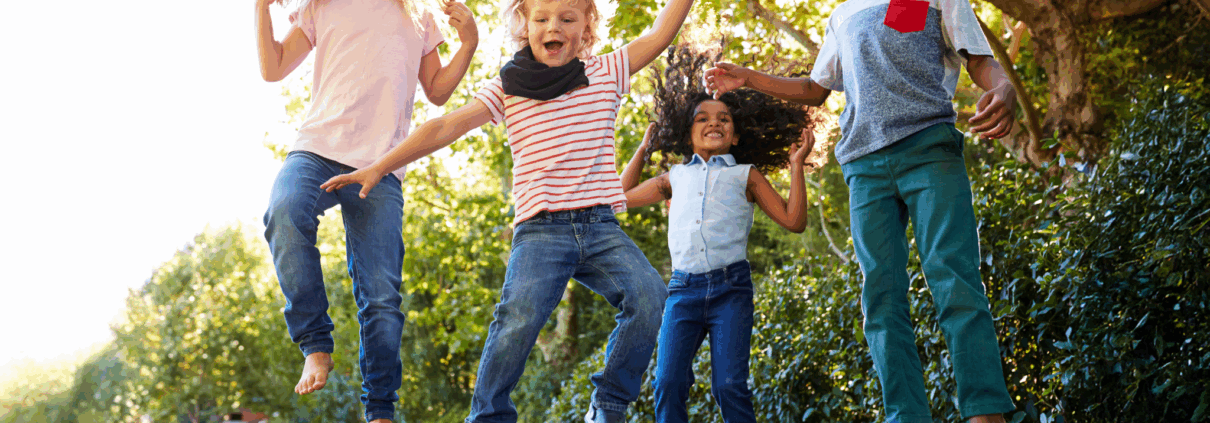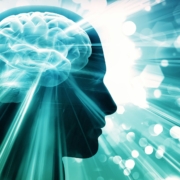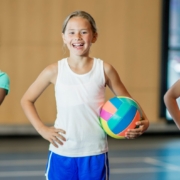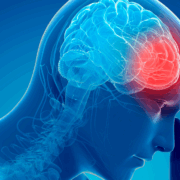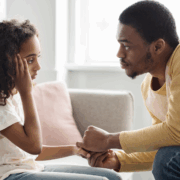Concussions: What Parents Should Know
It’s back to school time! As kids choose their first-day outfit, gather their school supplies, and get excited to meet up with classmates, parents have their own busy to-do list. But a critical lesson might be missing from your parental agenda: educating yourself about concussion risks and symptoms.
Children and teenagers have the highest risk of sustaining a concussion, which is a mild traumatic brain injury (TBI). Concussions are treatable—but a quick and proper diagnosis is important.
Each person’s concussion is different, and there’s no one-size-fits-all treatment. And what you might have heard about concussions when you were kid—or even five years ago—may no longer be the best advice. Here’s what you need to know:
A concussion is caused by a bump, blow or jolt to the head—or by a hit to the body that causes the head and brain to move rapidly back and forth.
“This sudden movement can cause the brain to bounce around or twist in the skull, creating chemical changes in the brain and sometimes stretching and damaging brain cells,” according to the Centers for Disease Control and Prevention. “These changes in the brain lead to symptoms that may affect how a child thinks, learns, feels, acts and sleeps. Symptoms are usually most severe right after the injury.”
Concussions are both underdiagnosed and overdiagnosed, so it’s important to get a proper diagnosis, said Kenneth Kutner, PhD, a clinical neuropsychologist in private practice and a clinical assistant professor of neuropsychology in the neurosurgery department at Weill Cornell Medicine in New York. Dr. Kutner has been the team neuropsychologist for the NFL’s New York Giants for over 30 years.
“Very often, kids can have dehydration that mimics a concussion,” he explained. “They can also have an abdominal injury—the wind knocked out of them—that mimics a concussion. I have seen a few cases in children in which they fall, but they fall from a seizure. So, the first thing we want to do medically is make sure a concussion actually occurred.”
The word “concussion” is sometimes used loosely by people anytime someone bumps their head hard, he said. But it’s important to know how and why a child hit their head. If they felt dizzy, fainted, had a seizure, or had low blood pressure and then fell, there may be another medical condition that needs checked out, with or without a concussion.
There are ways to prevent concussions, like making sure kids always wear properly fitted helmets when riding their bikes, scooters or ATVs, or when skiing or snowboarding. But kids can’t be encased in bubble wrap, and falls inevitably happen, whether at home, school or elsewhere.
Concussion Symptoms
Any bump to the head or hard hit should be evaluated by a medical professional. Certain symptoms are “red flags.” If a child experiences any of these, call 911 or seek emergency care:
- Neck pain or tenderness
- Seizures
- Loss of vision or having double vision
- Loss of consciousness
- Becoming more and more confused, less responsive or drowsy
- Weakness or tingling in more than one arm or leg
- Repeated vomiting
- Severe or increasing headache
- Increasingly restless, agitative or combative
- Visible deformity of the skull
Other less-severe concussion symptoms may include:
- Inattention
- Appearing dazed or stunned
- Confused about what just happened
- Headache
- Just not feeling “right”
Emergency room clinicians may want to do a CT scan or other imaging to rule out a brain bleed or other injuries. But it’s not necessary for only a concussion—a CT scan, MRI or X-ray cannot diagnosis a concussion. Concussions are diagnosed by a health care professional based on the symptoms.
Types of Concussions
There are five main types of concussions, based on the symptoms. Treatment depends on the type of concussion. The types and their potential symptoms are:
- Anxiety/mood: racing thoughts, worry, restlessness
- Cognitive fatigue: feeling extra tired, trouble concentrating and doing mental tasks, such as schoolwork
- Ocular (eyes): difficulty doing visual tasks, like reading books or watching screens
- Post-traumatic migraine: headaches, light sensitivity and feeling overwhelmed by noise, such as in crowded school hallways or sporting events
- Vestibular (balance): trouble with dizziness, imbalance, vertigo
Concussion Treatment
Once a concussion is diagnosed, a child is sometimes sent home with instructions to take it easy. While many concussions resolve on their own, parents may want to seek out a concussion specialist to ensure the best treatment for their child, said Michael “Mickey” Collins, PhD, clinical and executive director of the University of Pittsburgh Medical Center Sports Medicine Concussion Program. Dr. Collins is a clinical neuropsychologist and concussion expert. He is a consultant to the NFL’s Pittsburgh Steelers, NHL’s Pittsburgh Penguins and numerous other professional and collegiate organizations.
Ask the hospital team to refer you to a concussion clinic. If one doesn’t exist in your area, make an appointment with your child’s pediatrician and/or ask for a referral to a concussion specialist, Dr. Collins recommended.
“Once you really listen to the risk factors of the patient and the initial symptoms they had after the injury, we’ve created very good, standardized tools to evaluate the injury,” he said.
Concussions are treatable, he stressed. And seeing a concussion specialist helps ensure a proper diagnosis and treatment—one that is individualized for each patient.
Recovery time is different for everyone. Some people may feel better in a few days; others in a few weeks. Most people will have recovered within a month.
Speak to a health care professional before giving your child any medication to relieve headaches or other symptoms. In general, avoid ibuprofen (Advil or Motrin) and aspirin, which may increase the risk of a brain bleed. Instead, physicians may recommend acetaminophen (Tylenol).
Concussion treatment often includes rest, but gone are the days of staying isolated in a dark room for a week. Today, research has shown that recovery is faster and better when patients return to activities, but at a slower pace.
“For the first 24 hours to 48 hours, we recommend what’s called ‘relative rest,’” said Ruben Echemendia, PhD, a clinical neuropsychologist and owner of Psychological and Neurobehavioral Associates Inc. in State College, Pennsylvania. Dr. Echemendia is a past president of the National Academy of Neuropsychology; a consulting neuropsychologist for the NHL, Major League Soccer and the U.S. Soccer Federation; and a member of an NCAA concussion task force.
“That means that a child can go about their business as long as their symptoms don’t get worse or new symptoms develop,” Dr. Echemendia said. “It used to be thought that you couldn’t exercise, shouldn’t go for walks, that you should basically just sit and rest. We find that that’s no longer a good approach.”
A 2025 study in the Physical Therapy & Rehabilitation Journal showed that, in adults, those who received physical therapy (PT) sooner after a concussion experienced less dizziness and recovered better and faster than those who received PT much later.
Under the guidance of a concussion specialist, a child may be encouraged to do light exercise, like a supervised walk around the neighborhood, or go back to school after 1–2 days. Some kids may need to return to school with only half-days or be allowed to leave class early to avoid noisy, crowded hallways. Again, it depends on the type of concussion and how each child feels.
“A good approach is if they feel like they can walk, and they can walk without having a headache, they can go out and walk the dog with supervision. If they feel like they want to watch TV, they can, but in very limited time frames and as long as their symptoms don’t get worse or new symptoms develop,” Dr. Echemendia said. “They can read, as long as symptoms don’t get worse and or new symptoms develop.
“It’s really starting to gradually introduce more and more physical activity and more and more cognitive activity for the child, determine the extent to which they can tolerate that activity, and then gradually increase that activity over time, both cognitive and physical.”
Kids and teenagers should not return to sports or any activity that has a risk of falling or collision, like gym class or recess, until their symptoms have gone away and they have been given the “all clear” by a medical professional.
Emotional Symptoms
After a concussion, some kids and teenagers may also experience emotional reactions, like fear, anger, sadness or anxiety.
“When a young person who really doesn’t understand what a concussion is, gets hit and has a concussion, all of a sudden, they don’t feel right. They don’t understand how they’re feeling,” Dr. Echemendia said. “They may be more emotional than usual. They may have trouble sleeping, which then leads to increased emotionality. They may be anxious because they’re now sitting out from their sport. They may have more difficulty in school. All of those factors create anxiety, sadness, frustration.”
If a child experiences any of those symptoms, parents may want to make an appointment with a concussion clinic or a specialist who works on the psychological aspects of a concussion, such as a neuropsychologist. A concussion specialist can “help the child understand what is happening to them, that it is a part of the injury, and that they’re going to get better,” Dr. Echemendia said.
Let Kids Be Kids
Every day parents make risk calculations of what they allow their children to do, weighing the risks versus benefits. While some sports can put children at risk of concussion, so can playing in the backyard or walking the dog.
“Sports are important to many kids, and if they love hockey, they love soccer, they love basketball, or whatever it is, my recommendation is that parents let their kids play sports because it’s a great opportunity,” Dr. Collins said. “Sports are very good for so many other reasons: social, physical activity.”
He stressed again: Concussions are treatable. “I want parents to be educated that when these signs and symptoms occur, get the right treatments early on.”
That’s going to improve healing and recovery, he said. “The whole conversation changes if parents understand that if you have an injury, the right treatment can be applied, and the outcomes can be very good, and it’s going to allow the athlete to continue playing the sport they love.”

